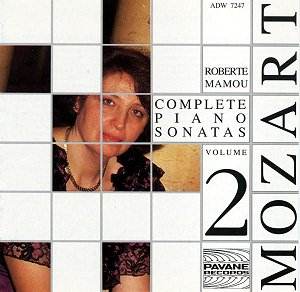 Composer: Wolfgang Amadeus Mozart
Composer: Wolfgang Amadeus Mozart
Works: Piano Sonata No. 1 in C major, K. 279; Piano Sonata No. 2 in F major, K. 280; Piano Sonata No. 3 in B flat major, K. 281; Piano Sonata No. 4 in E flat major, K. 282; Piano Sonata No. 5 in G major, K. 283; Piano Sonata No. 6 in D major, K. 284/205b; Piano Sonata No. 7 in C major, K. 309; Piano Sonata No. 8 in A minor, K. 310; Piano Sonata No. 9 in D major, K. 311; Piano Sonata No. 10 in C major, K. 330; Piano Sonata No. 11 in A major (“Alla Turca”), K. 331; Piano Sonata No. 12 in F major, K. 332; Piano Sonata No. 13 in B flat major, K. 333; Fantasia for piano in C minor, K. 475; Piano Sonata No. 14 in C minor, K. 457; Piano Sonata No. 15 in C major (“Sonata semplice”), K. 545; Piano Sonata No. 16 in B flat major, K. 570; Piano Sonata No. 17 in D major (“Trumpet”, “Hunt”), K. 576; Piano Sonata No. 18 in F major, K. 533/494
Performers: Mitsuko Uchida, piano
Recording: Rec: 1983 – 1987, Henry Wood Hall, London
Label: PHILIPS
Mozart’s piano sonatas, composed during the Classical era, encapsulate the essence of balance, clarity, and expressive depth that characterize his oeuvre. These works, spanning from K. 279 to K. 576, reflect not only the technical evolution of piano music but also the composer’s intimate engagement with the instrument. Mitsuko Uchida’s comprehensive 5-CD set captures this spirit with remarkable fidelity and sensitivity, offering listeners an opportunity to explore the nuances of Mozart’s early and mature styles across an impressive repertoire.
Uchida’s interpretation is distinguished by its refined touch and transparent musicality. Her performances radiate an enchanting lightness, allowing the intricate counterpoint and melodic lines to emerge with clarity. In the first movement of Sonata No. 8 in A minor, K. 310, Uchida deftly balances the turbulent emotional landscape with a measured intensity, never losing the lyrical quality that is essential to Mozart’s music. Her use of dynamics is particularly noteworthy; the soft, flowing lines in the second movement are rendered with a delicate touch that evokes a sense of intimacy while remaining firmly grounded in the score’s intentions.
The technical prowess exhibited by Uchida is equally compelling. Her articulation in the rapid passages of Sonata No. 11 in A major, K. 331—especially in the “Alla Turca” finale—demonstrates an impressive command of the keyboard. Yet, despite the inherent virtuosity of the sonatas, she avoids the pitfall of ostentation. Each ornamentation is thoughtfully integrated, enhancing the musical narrative rather than distracting from it. The clarity of her phrasing allows the listener to appreciate the conversational interplay between voices, a hallmark of Mozart’s compositional style.
The recording quality of this set is exemplary, showcasing Uchida’s piano with a warm, natural resonance that enhances the listening experience. The engineering captures the instrument’s tonal richness without the interference of artificial reverberation, allowing the music to breathe authentically. This sonic transparency is particularly effective in the Fantasia in C minor, K. 475, where the shifting moods are conveyed with such conviction that one feels enveloped in the music’s emotional depth. The balance between the piano and the acoustic environment is meticulously crafted, ensuring that every note rings true and every dynamic nuance is palpable.
In the realm of Mozartian piano recordings, Uchida’s set stands as a paragon of interpretive integrity and musical insight. Her ability to convey the essence of each sonata without imposing a personal agenda is a rare quality that elevates this collection. The performances resonate with humility and subtlety, inviting listeners into a reflective space where the music can speak for itself. This set is not merely a collection of recordings; it is an invitation to experience Mozart’s genius through the lens of one of the finest interpreters of our time. It is essential listening for anyone wishing to delve deeply into the heart of Mozart’s piano repertoire.



